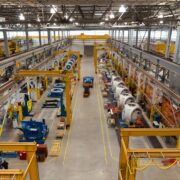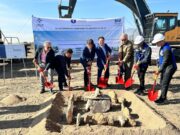The nearshoring boom has benefited Mexican industry, but it has also made more evident the challenges the country faces in receiving investors, mainly in terms of logistics infrastructure.
Josefina Moisés, general director of the Mexican Association of Real Estate Fibers (AMEFIBRA), assured that 500 companies attracted by nearshoring took their factories, production lines and distribution centers out of Asia to move them and install them in Mexico.
“Around 500 companies have established themselves in the country, boosting the demand for industrial space as a result of nearshoring,” said the representative.
According to the leader, the nearshoring boom has benefited Mexican industry, but it has also made more evident the challenges that the country has to receive investors, mainly in terms of logistics infrastructure.
Some of the main opportunities for a solid growth of the real estate industry in Mexico are in nearshoring, tourism and infrastructure.
“We have a good labor force, but also the macroeconomic stability, interest rates and stable exchange rate allow investors to evaluate the relocation of their production areas to Mexico,” she said.
The general director of AMEFIBRA said that the arrival of new companies has triggered a demand for industrial parks, so work must be done to improve the road and telecommunications network:
“All this in order to provide great benefits to foreign companies so that they decide to locate in our country,” she mentioned.
He recalled that the real estate market continues to be a solid and reliable option, capable of resisting global economic crises, despite the risks inherent to any investment, he said.
Mexico’s strategic location and good property costs, diverse types of industries, growing market, beneficial business conditions, low labor costs and cost savings are attractive, said Josefina Moises.
The Ministry of Economy informed that foreign direct investment (FDI) at the end of the third quarter of 2023 stood at 32.926 billion dollars, registering an increase of 30 percent compared to the 25.272 billion dollars reached in the same period of 2022.
The agency highlighted that the increase is the result of the confidence of foreign investors due to the good business environment and the country’s economic stability.
“Although there are a large number of properties, warehouses and industrial parks in Mexico, the choice of the most suitable one will always depend on the needs and objectives of each company, like a tailor-made suit,” said the executive.
During 2022, supply increased and closed the year at 3.98 million m2 , increasing by more than 290 thousand m2 since the beginning of the year. Even so, supply remains compressed due to the strong demand for industrial space and several conditions that have created obstacles to the development of new speculative projects.
Among these conditions are energy shortages, rising land prices, and the general rise in the cost of construction inputs and interest rates.
FIBRAs currently have more than 2,000 properties with more than 35 million meters of GLA, and more than 500,000 jobs have been created, 50,000 directly and 450,000 indirectly.
“Another point to highlight is that developers in Mexico are implementing the construction of sustainable buildings,” said Josefina Moises.
Strategies will have to be implemented to enable the implementation of new technologies, achieving long-term savings of at least 40 percent in energy, 20 percent in water and 20 percent in energy embedded in materials by 2050.

Source: Forbes



